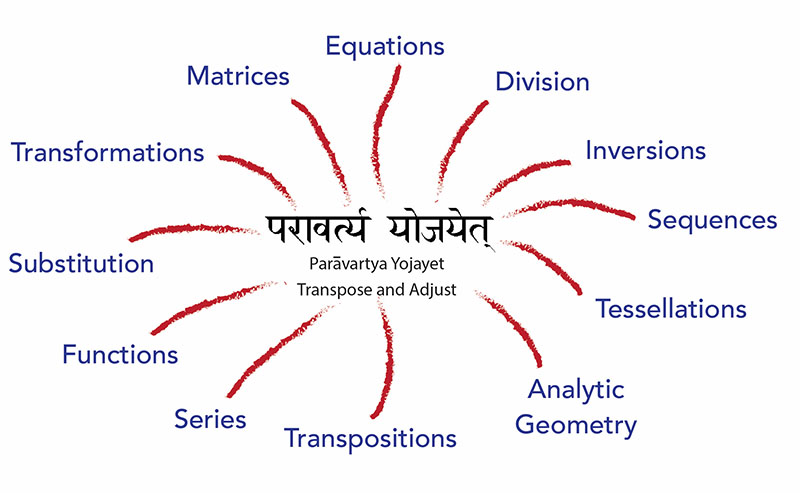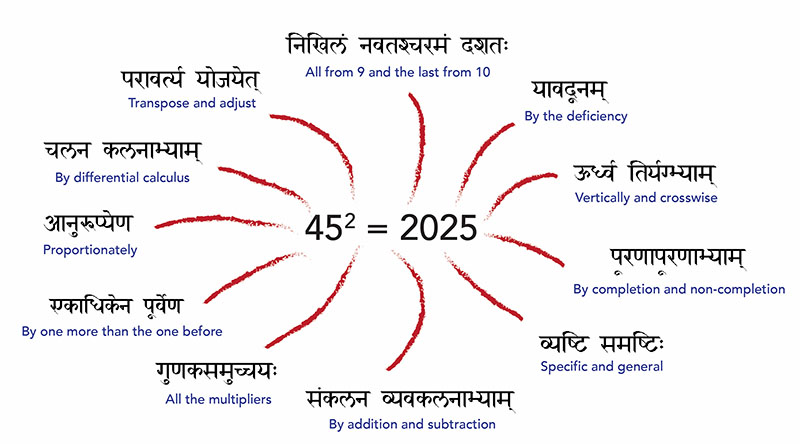Sutras
The word “sutra” means “thread of knowledge” and is a pithy statement expressing a law or rule or formula or principle or pattern of working. The idea of thread is that a sutra is like the thread of a pearl necklace by which the pearls are strung together and connected to each other

The sutras are highly flexible and connect together apparently disparate topics because the pattern or mental process within those topics is the same.
At the same time a single problem can have multiple paths to a solution, where each strategy is expressed by a different sutra or combination of sutras.

Here is a list of the sutras and sub-sutras in Sanskrit, transliteration, and translation.
















Useful Notes And Comments About The Sutras
This list of sutras adheres very closely to the list compiled from references in the text by the general editor of Vedic Mathematics, written by Sri Sankaracarya Bharati Krishna Tirtha. There are a few amomalies in the editor’s list. The comments below describe some of the general properties of the sutras and sub-sutras and, in comment 9, explain any alterations from the editor’s list.
1. The sutras vary in their range of application. Some have a very limited number of applications whilst others are seen operating in countless instances.
2. Sub-sutras generally act in support of a main sutra. Sometimes, they are corollaries of main sutras. Due to their flexibility, sutras and sub-sutras are often interchangeable. A sub-sutra can act as a sutra and vice versa.
3. In several instances, only part of a sutra is seen to be operative. For example, the sutra, By addition and subtraction, is applicable to adding a bunch of numbers. Addition is the active process whilst the passive process is that, in the process of arriving at a total, the number of numbers has been subtracted.
4. More than one sutra can be applicable in any one instance. In many cases, sub-sutras act in support of sutras but the reverse is also possible.
5. The sutras can act as an over-riding principle or act as an instantaneous mental process within any activity.
6. The sutras express naturally occurring mental processes and are not limited to the realm of mathematics.
7. Some of the sutras have meanings that are fundamental to our cognitative perception of the world. For example, “When the total is the same, it is zero”, expresses the knowledge of equality as in, “When two things are the same, there is no difference”.
8. Some of the translations do not carry the full import of meaning. For example, Antyayoreva, is usually translated as, “Only the final two terms”. However, “Antyayoh” can also mean, “Outer terms”; and this meaning has many applications.
9. The list of sutras in Vedic Mathematics by Sri Sankaracarya Bharati Krishna Tirtha was compiled in the 1960s, by the general editor, from stray references in the text. The list contains anomalies and is very slightly different from the list set out above. These small changes have arisen from thorough analysis of the text, penetraton of the meaning of the sutras in Sanskrit, together with decades of research into the applications of the sutras.
The details are set out as follows:
a) Sub-sutra 6, in the editor’s list, Yavadunam Tavadunam, does not appear in the text so this has been removed. However, the full sub-sutra, which is sub-sutra 7 in the editor’s list stands at sub-sutra 5 in the list above.
b) Dhvajanka – On top of the flag, does not appear in the editor’s list but in Chapter 27 of Vedic Mathematics it is stated to be a sutra for Straight Division under the general sutra, Vertically and crosswise. It is therefore placed in our list of sub-sutras.
c) We have replaced sutra 15 with sub-sutra 13 as this appears to be the full version, namely, Gunitasamuccayah Samuccayagunitah. Subsequently, sutra 15 (editor’s list) – Gunitasamuccayah, and its counterpart – Samuccayagunitah, have been placed in the list of sub-sutras. Furthermore, there is an anomaly with BKT’s translation because Gunitasamuccaya is a tatpurusha genative compound in Sanskrit and should mean ‘Sum of the product’ instead of ‘Product of the sum’. However, given some poetic licence, it is not of significant importance.
d) Sub-sutra 13 in the list above has been constructed from a single transliterated reference in the text in Chapter 39. It is clearly a rule of great potence in a variety of mathematical contexts.
e) Sub-sutras 14, 15 and 16 in the list above are stated as sub-sutras in the text but are not included in the editor’s list.

